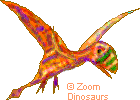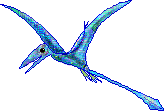ANATOMY
 Pterosaurs were an order of flying reptiles that lived during the time of the dinosaurs. The pterosaurs ranged in size from a few inches to over 40 feet. They had hollow bones, were lightly built, and had small bodies. They had large brains and good eyesight. Some pterosaurs had fur on their bodies, and some (like Pteranodon) had light-weight, bony crests on their heads that may have acted as a rudder when flying, or may have been a sexual characteristic.
Pterosaurs were an order of flying reptiles that lived during the time of the dinosaurs. The pterosaurs ranged in size from a few inches to over 40 feet. They had hollow bones, were lightly built, and had small bodies. They had large brains and good eyesight. Some pterosaurs had fur on their bodies, and some (like Pteranodon) had light-weight, bony crests on their heads that may have acted as a rudder when flying, or may have been a sexual characteristic.
Pterosaur wings were covered by a leathery membrane. This thin but tough membrane stretched between its body, the top of its legs and its elongated fourth fingers, forming the structure of the wing. Claws protruded from the other fingers.
 Pterosaurs could flap their wings and fly with power, but the largest ones (like Quetzalcoatlus, which had a wingspan up to 36 feet or 11 m wide) probably relied on updrafts (rising warm air) and breezes to help in flying.
Pterosaurs could flap their wings and fly with power, but the largest ones (like Quetzalcoatlus, which had a wingspan up to 36 feet or 11 m wide) probably relied on updrafts (rising warm air) and breezes to help in flying.
WHEN PTEROSAURS LIVED
Pterosaurs lived during the Mesozoic Era, the Age of Reptiles. The primitive types of pterosaurs (rhamphorhynchoids) appeared during the Triassic, and died out at the end of the Jurassic period. More advanced pterosaurs (pterodactyloids) appeared late in the Jurassic period and died out during the Cretaceous, about 65 million years ago, during the K-T extinction (65 mya).
DIET
Pterosaurs were carnivores; they ate fish (which they caught at the surface of the oceans), mollusks, crabs, perhaps plankton (for some species), insects, and scavenged dead animals on land.
LOCOMOTION
 Pterosaurs flew long distances using large, light-weight wings.
Pterosaurs flew long distances using large, light-weight wings.
CLASSIFICATION
Pterosaurs were reptiles, but not dinosaurs. By definition, all dinosaurs were diapsid reptiles with an upright stance. Pterosaurs probably had a semi-upright stance. There is a small minority of paleontologists who think that the pterosaurs' stance could have been upright and that pterosaurs should therefore be included in the clade of dinosaurs (being derived theropods). Either way, dinosaurs and pterosaurs are certainly closely related.
Pterosaurs were:
- Kingdom Animalia (animals)
- Phylum Chordata (chordates)
- Subphylum Vertebrata (vertebrates)
- Superclass Tetrapoda (four-legged animals)
- Class Diapsids - these include all the reptiles (except turtles) and birds. They are distinguished by having two holes in the rear upper part of their skulls and two holes behind the eyes.
- Sublass Archosauria - this group includes dinosaurs, crocodilians, pterosaurs, birds, etc.
- Order Order Pterosauria - flying reptiles. There are two type of pterosaurs:
- Suborder Rhamphorhynchoidea ("prow beaks") - early pterosaurs that appeared during the Triassic period and went extinct at the end of the Jurassic, that had long tails, short necks, and long, narrow wings. These were the first flying vertebrates and probably flapped their wings to fly. They include:
- Genus Eudimorphodon - 2.5 feet (0.75 m) long wingspan, with large eyes, a short neck, many sharp teeth in pointed jaws (for eating fish and insects), and a diamond-shaped flap of skin at the end of the long, pointed tail. From Italy during the late Triassic period.
 Genus Dimorphodon - 4 feet (1.2 m) long wingspan, with deep, wide jaws resembling the beak of the modern-day puffin, a short neck, and a diamond-shaped flap of skin at the end of the long, pointed tail. From England during the early Jurassic period.
Genus Dimorphodon - 4 feet (1.2 m) long wingspan, with deep, wide jaws resembling the beak of the modern-day puffin, a short neck, and a diamond-shaped flap of skin at the end of the long, pointed tail. From England during the early Jurassic period.
- Genus Campylognathoides - 20 ft (6 m) wide wingspan. It had a long tail. From Germany and India during the early Jurassic period. Named by Strand in 1928
 Genus Rhamphorhynchus - 3.25 feet (1 m) wide wingspan with long, narrow jaws, sharp teeth pointing outwards, and a diamond-shaped flap of skin at the end of the very long, pointed tail. From Solnhofen, Germany and Tanzania during the late Jurassic period.
Genus Rhamphorhynchus - 3.25 feet (1 m) wide wingspan with long, narrow jaws, sharp teeth pointing outwards, and a diamond-shaped flap of skin at the end of the very long, pointed tail. From Solnhofen, Germany and Tanzania during the late Jurassic period.
- Genus Scaphognathus - (meaning canoe jaw) 3.25 feet (1 m) wide wingspan with good eyesight, a poor sense of smell, and a diamond-shaped flap of skin at the end of the long, pointed tail. From England during the late Jurassic period. Named by Wagner in 1861.
- Genus Sordes - 1.5 ft (0.5 m) wide wingspan with a thick, hairy coat on the body (but not on the tail or wings), a long, pointed tail, and no head crest. From Kazakhstan, Asia during the late Jurassic period.
- Genus Anurognathus - 1 ft (30 cm) wide wingspan with wide, deep, puffin-like jaws and peg-like teeth. It probably ate insects. It had a short tail. From Germany during the late Jurassic period.
- Suborder Pterodactyloidea ("wing finger") - their descendants that appeared late in the Jurassic and died in the K-T extinction, 65 million years ago, that had shorter tails. Most probably flapped their wings to fly, except the larger species, including Pteranodon and Quetzalcoatlus. They include:
- Genus Pterodactylus - 2.5 feet (0.75 m) wide wingspan with long, narrow jaws and sharp teeth, and no head crest. From Tanzania, Africa, England, France, and Germany during the late Jurassic period.
- Genus Pterodaustro - 4 feet (1.2 m) wide wingspan with very long, thick, blunt jaws with long teeth in the lower jaw and tiny teeth in the upper jaw. It may have gathered food by skimming it from the ocean surface. From Argentina during the late Jurassic period.
- Genus Cearadactylus - 13 feet (4 m) wide wingspan with protruding, interlocking teeth. From Brazil during the early Cretaceous period.
 Genus Dsungaripterus - 10 feet (3 m) wide wingspan with an unusual bony crest running along its snout, and long, narrow, curved jaws with a pointed tip. It had flat teeth at the back of the jaws, probably for crushing the shells of its prey. From China during the early Cretaceous period.
Genus Dsungaripterus - 10 feet (3 m) wide wingspan with an unusual bony crest running along its snout, and long, narrow, curved jaws with a pointed tip. It had flat teeth at the back of the jaws, probably for crushing the shells of its prey. From China during the early Cretaceous period.
 Genus Pteranodon - 23 feet (7 m) wide wingspan with no teeth, no tail, a long beak, and a very long, bony head crest. It glided along rather than flapping its wings. From England and Kansas, USA during the late Cretaceous period.
Genus Pteranodon - 23 feet (7 m) wide wingspan with no teeth, no tail, a long beak, and a very long, bony head crest. It glided along rather than flapping its wings. From England and Kansas, USA during the late Cretaceous period.
- Genus Quetzalcoatlus - 36 feet (11 m) wide wingspan, the largest flying animal ever. It glided along rather than flapping its wings. It had long, pointed, toothless jaws, and a long, curved neck. From Texas, USA during the late Cretaceous period.
DISCOVERY OF FOSSILS
Pterosaur fossils have been found in North America, Europe, Africa, and Australia. The first pterosaur (flying reptile) was found in 1784 in Solnhofen limestone (in Bavaria, Germany) by an Italian naturalist named Cosmo Alessandro Collini. It was first thought to be a marine animal - it was later determined to be a flying reptile and was named "pterodactyle" (by Georges Cuvier in 1809).
PTEROSAUR LINKS
A first-grade level Pterosaur addition activity print-out.
Pterodactyl information sheet from Enchanted Learning.
Pterosaurs from the UCMP, Berkeley.
Quetzalcoatlus information sheet from Enchanted Learning.
Pteranodon information sheet from Enchanted Learning.
Quetzalcoatlus, the giant pterosaur, at the Royal Tyrrell Museum, Canada.
The Aerodynamics of Pterosaurs from UC Davis.


Pterosaurs could flap their wings and fly with power, but the largest ones (like Quetzalcoatlus, which had a wingspan up to 36 feet or 11 m wide) probably relied on updrafts (rising warm air) and breezes to help in flying.
Pterosaurs flew long distances using large, light-weight wings.
